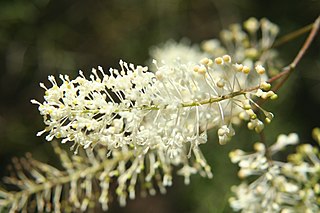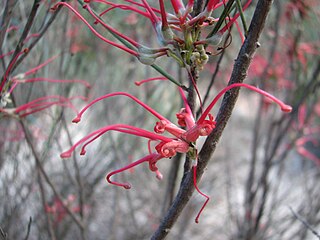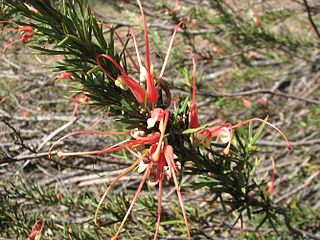
Grevillea leptopoda is a species of flowering plant in the family Proteaceae and is endemic to the south-west of Western Australia. It is a spreading to erect shrub with divided leaves, the lobes further divided, the end lobes linear, and clusters of white to cream-coloured flowers.

Grevillea vestita is species of flowering plant in the family Proteaceae and is endemic to the south-west of Western Australia. It is an erect, spreading, prickly shrub with lobed leaves, the number and arrangement of lobes depending on subspecies, and more or less spherical to dome-shaped clusters of hairy, white to cream-coloured flowers sometimes tinged with pink.

Grevillea levis is a species of flowering plant in the family Proteaceae and is endemic to the west of Western Australia. It is a dense shrub with divided leaves, the end lobes linear and sharply pointed, and clusters of white to cream-coloured flowers, sometimes flushed with pink.

Grevillea paniculata, commonly known as kerosene bush, is a species of flowering plant in the family Proteaceae and is endemic to the south-west of Western Australia. It is a dense shrub with divided leaves, the lobes linear, and more or less spherical clusters of white to cream-coloured flowers.

Grevillea annulifera, also known as prickly plume grevillea, is a species of flowering plant in the family Proteaceae and is endemic to northern Western Australia. It is a spreading to erect shrub with pinnatisect leaves with five to nine sharply-pointed, linear lobes, and cream-coloured to pale yellow flowers.

Grevillea corrugata is a species of flowering plant in the family Proteaceae and is endemic to a restricted area in the south-west of Western Australia. It is a dense shrub with deeply divided leaves usually with three to five sharply-pointed, linear lobes, and white to cream-coloured flowers.

Grevillea georgeana is a species of flowering plant in the family Proteaceae and is endemic to inland areas of south-western Western Australia. It is an erect to widely spreading shrub with deeply divided leaves, the end lobes linear and sharply pointed, and scarlet to bright reddish-pink and cream-coloured flowers.

Grevillea sarissa, commonly known as wheel grevillea, is a species of flowering plant in the family Proteaceae and is native to South Australia and Western Australia. It is a spreading shrub, usually with linear leaves, and more or less erect, wheel-like to more or less spherical clusters of red or yellow flowers.

Grevillea rivularis, commonly known as Carrington Falls grevillea, is a species of flowering plant in the family Proteaceae and is endemic to New South Wales. It is a dense, spreading shrub with divided leaves with more or less linear, sharply-pointed lobes, and clusters of cream-coloured flowers that turn pink or grey as they age.

Grevillea tripartita is species of flowering plant in the family Proteaceae and is endemic to the south-west of Western Australia. It is an erect, prickly shrub with divided leaves with 3 lobes, and clusters of red and cream-coloured or reddish-orange and yellow flowers.

Grevillea leucoclada is a species of flowering plant in the family Proteaceae and is endemic to a small area in the west of Western Australia. It is a shrub with divided leaves, the lobes further divided, the end lobes linear or tapered, and cone-shaped clusters of white to cream-coloured flowers.

Grevillea brachystachya, commonly known as short-spiked grevillea, is a species of flowering plant in the family Proteaceae and is endemic to the south-west of Western Australia. It is a bushy shrub with linear leaves and more or less spherical clusters of cream-coloured to greenish flowers.

Grevillea erinacea is a species of flowering plant in the family Proteaceae and is endemic to the south-west of Western Australia. It is a spreading shrub with deeply-divided leaves with three to five linear lobes, rotated through 90°, and cream-coloured flowers with a white style.

Grevillea erythroclada, commonly called needle-leaf grevillea, is a species of flowering plant in the family Proteaceae and is endemic to northern Australia. It is a shrub or small tree with divided leaves, the ultimate lobes linear to more or less cylindrical, and clusters of cream-coloured to pale yellow flowers.

Grevillea muelleri is a species of flowering plant in the family Proteaceae and is endemic to the a relatively small area of south-western Western Australia. It is a shrub with linear to narrowly oblong, or divided leaves with linear or narrowly egg-shaped lobes, more or less spherical clusters of white to cream-coloured flowers.
Grevillea murex is a species of flowering plant in the family Proteaceae and is endemic to a relatively small area of south-western Western Australia. It is a spreading, much-branched shrub with hand-shaped leaves and clusters of greenish-white to dull cream-coloured flowers.
Grevillea rogersoniana, commonly known as Rogerson's grevillea, is a species of flowering plant in the family Proteaceae and is endemic to a restricted area near Shark Bay in Western Australia. It is an erect shrub with spatula-shaped leaves with 3 to 5 teeth or shallow lobes on the end, and cylindrical clusters of reddish pink flowers, the style with a cream-coloured tip.

Grevillea scabra, commonly known as the rough-leaved grevillea, is a species of flowering plant in the family Proteaceae and is endemic to the south-west of Western Australia. It is a low, open shrub with clusters of narrowly elliptic to more or less linear leaves and small clusters of white to cream-coloured flowers.

Grevillea spinosissima is species of flowering plant in the family Proteaceae and is endemic to the southwest of Western Australia. It is a spiny shrub with three-part leaves with sharply-pointed, linear lobes, and clusters of creamy-white and green to mauve flowers with a white style.
Grevillea saxicola is a species of flowering plant in the family Proteaceae and is endemic to the Pilbara region of Western Australia. It is a shrub or small tree usually with pinnatisect leaves with linear lobes, and cylindrical clusters of cream-coloured to pale yellow flowers.

















